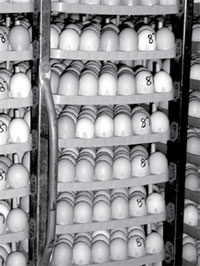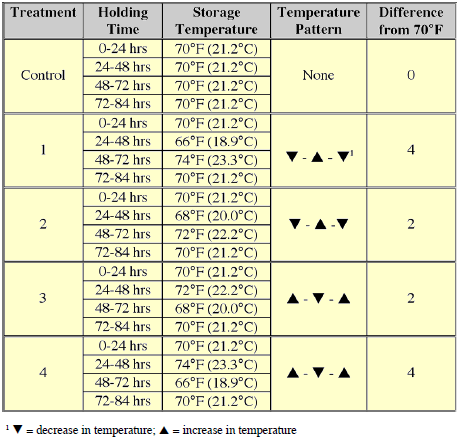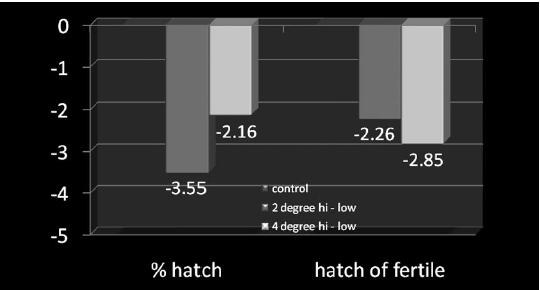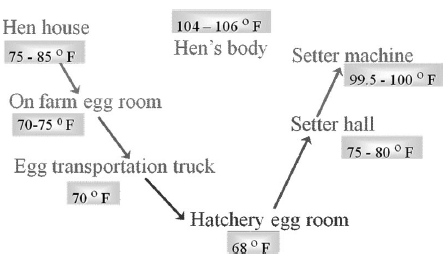



Temperature Variation in On-Farm Hatching Egg Holding Units
The effects of oscillating and variable on-farm egg storage temperatures on hatchability and embryo viability in commercial broiler breeder flocks were studied by Dr Keith Bramwell, extension poultry specialist at the University of Arkansas in the Summer 2008 issue of Avian Advice.
Introduction
Broiler breeder hatching eggs are commonly held in storage facilities at the breeder farm anywhere from one to four days and again at the hatchery until placed in the setters. In the poultry industry, some pre-incubation of hatching eggs following oviposition and during storage is inevitable, yet efforts should be made to reduce this occurrence.
With the continued development of this industry there have been tremendous advances which have improved the available equipment to maintain hen house temperatures, and the quality of egg transportation vehicles and egg storage facilities in the hatchery. However, with this improved technology, on-farm egg storage facilities have been largely neglected which has made it extremely difficult for producers to maintain constant egg storage room temperatures at the farm level.
 |
While one purpose of egg storage is to accumulate eggs to meet the demand for chicks and to best utilize hatchery facilities, ultimately the goal is to arrest further embryonic development while maintaining embryo viability.
While an egg storage temperature of 68°F (20°C) is the most commonly practised industry recommendation, the actual on-farm egg storage temperature can range from a low of 60°F (15.6°C) up to 75°F (23.9°C). The range in egg storage temperature from one farm to the next is often due to different management programs, while day-to-day fluctuation within the same company is a result of poor egg storage facilities that are unable to maintain a constant storage temperature.
Hatchery egg storage conditions have been evaluated in the past, with recommendations presented to reduce losses in hatchability. However, research regarding egg storage at the breeder farm is limited and incomplete. The objective of this study was to determine the effects of oscillating and variable on-farm egg storage temperatures on hatchability and embryo viability in commercial broiler breeder flocks.
Egg Storage and Hatching Procedures
A total of 4320 hatching eggs were obtained from the University of Arkansas’s Broiler Breeder Research facility and placed into two separate egg storage chambers, with all eggs stored at a control temperature of 70°F (21.1°C) for 0-24 hours.
After the initial 24-hour storage period, eggs were divided into 864 egg lots and assigned to treatment groups. One group of eggs remained at 70°F for the entire 72-hour storage period (control). Four other groups were moved to separate storage chamber with temperatures set at either 66°F (18.9° C), 68°F (20.0°C), 72°F (22.2°C) or 74°F (23.3°C) to represent Treatments 1, 2, 3 and 4, respectively.
Eggs were stored at these temperatures for an additional 24 hours for a total of 48 hours of storage time. Then eggs stored at 66°F were stored at 74°F, eggs at 74°F were stored at 66°F, eggs at 68°F were stored at 72°F, and eggs at 72°F were stored at 68°F for an another 24 hours for a total storage time of 72 hours.
After 72 hours of storage, all eggs were returned to 70°F.
Treatment details are outlined in Table 1. This design ensured that all eggs in this experiment were held at an average of 70°F for the entire three-day “on-farm” egg storage time period.
To summarize this design, all hatching eggs from the different temperature treatment groups were subjected to either a 2- or 4-degree F temperature fluctuation above and below the 70°F base temperature but were held at an average of 70°F.
Table 1. Egg storage temperature treatments

After the storage period, eggs were transported to their original commercial breeder farm where they were placed directly on a commercial hatching egg transportation truck and sent to a commercial hatchery for incubation. No treatment or special care took place after the on-farm storage period.
Results and Discussion
* "Data from this research indicate that variations in on-farm egg storage temperatures of as little as 2°F can reduce hatchability by as much as 3.5%" |
The hatchability of eggs subjected to a 2°F temperature change from 70°F was reduced by nearly 2% compared to the control group (74.69 vs. 76.47% hatch, respectively). Eggs that underwent a 4°F temperature change had nearly a 1% loss in hatch as compared to the control group (75.61 vs. 76.47%, respectively). It is interesting to note that the greater temperature variation did not necessarily result in a greater loss in hatchability.
However, regardless of whether the temperature variation was 2 or 4°F, all hatching eggs used in the study moved from the hen house at about 80°F to the 70°F storage chamber for 24 hours.
Eggs that then increased in temperature for 24 hours and decreased for another 24 hours before increasing again to 70°F (i.e. 70°F-Δ-∇-Δ) experienced a significant drop in hatchability as compared to the control (3.55% and 2.16% loss in hatch, respectively, Figure 1).
Eggs in this group experienced multiple changes in temperature from the hen house to the hatchery. From the time of lay, these eggs decreased in temperature to 70°F then the temperature was raised for 24 hours, then lowered for 24 hours, then raised for 24 hours, then lowered as they were moved to the hatchery (67°F) then raised when moved to the setters (three periods of decreasing temperatures and three with increasing temperatures).
Figure 1. Hatchability Loss due to Egg Storage Temperature Variation

Eggs that were stored at 70°F then decreased in temperature for 24 hours, then increased after 48 hours then were returned back to 70°F (70-Δ-∇-Δ) experienced no difference in hatchability and less than 1% loss in hatch of fertile. Eggs in this treatment group basically underwent one change in direction of the temperature they were subjected to from the time they were laid until the eggs reached the commercial hatchery. These eggs decreased in temperature after lay to 70°F, then the temperature was decreased again for 24 hours, then increased for 24 hours, then decreased for 24 hours, then decreased again as they were moved to the hatchery (67°F) then raised when moved to the setters (two periods where temperatures were decreasing and two with increasing temperatures).
Each time the internal temperature of the egg is elevated to near 75°F, metabolic activity is again initiated and embryo development ensues only to be slowed again during additional egg cooling).
While cooling hatching eggs is necessary, starting and stopping embryo development weakens the embryo and reduces its viability. As illustrated in Figure 2, the ideal situation is for hatching eggs to undergo only two temperature direction changes; one from the hen to the lowest temperature point at the commercial hatchery egg storage facility and the second temperature direction as eggs are moved into the egg setters.
Figure 2. Ideal temperature changes for hatching eggs.

Conclusions
It is well known that most hatchability problems are a result of poor fertility. However, when egg production is attained and the flock maintains high levels of fertility, how we care for hatching eggs can have a tremendous effect on overall hatchability.
While current industry recommendations vary from 63°F to 70°F for on-farm egg storage, data from this research indicate that variations in on-farm egg storage temperatures of as little as 2°F can reduce hatchability by as much as 3.5%.
Experience from evaluating current on-farm egg room temperature values indicates that variation in the actual temperature and the set temperatures are great and often exceed those parameters established in this study. Therefore, regardless of the equipment in the breeder house and the hatchery facilities, hatchability is routinely lost in commercial hatcheries due to neglect of the on-farm egg storage facilities.
Summary
- Maintaining a constant environment for hatching eggs prior to incubation is critical to achieve optimum hatchability.
- Excessive temperature variation in on-farm hatching egg storage can cause hatchability losses of up to 3.5%.
- Monitor egg storage and transportation conditions using temperature data loggers.
- Make adjustments to equipment to provide hatching eggs with a constant environment. This can include stirring fans in egg rooms, improved heating and cooling equipment, and improved insulation properties in the egg room.
October 2008








